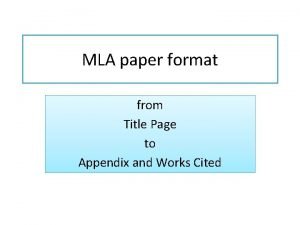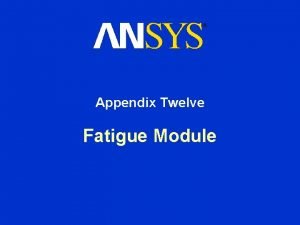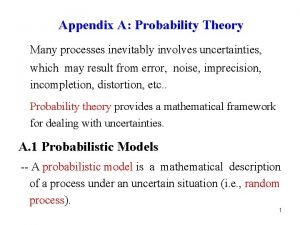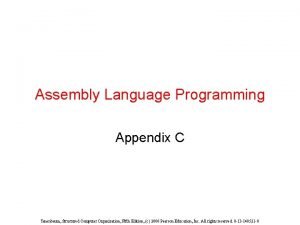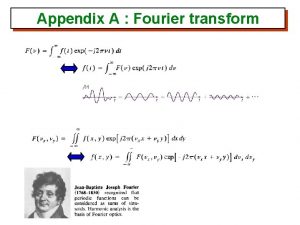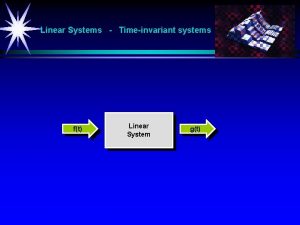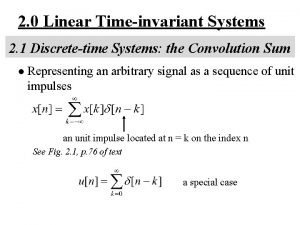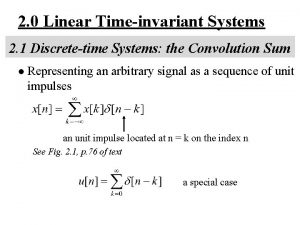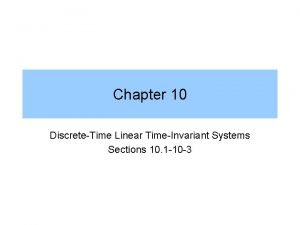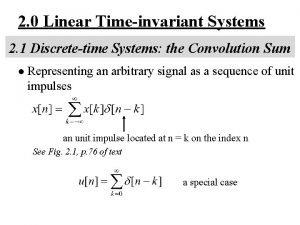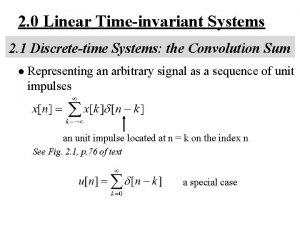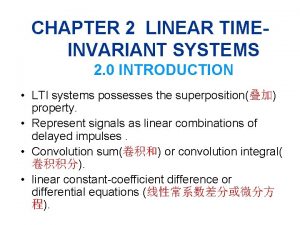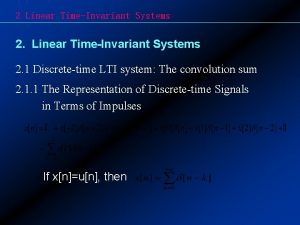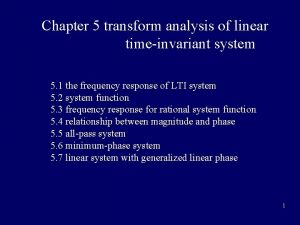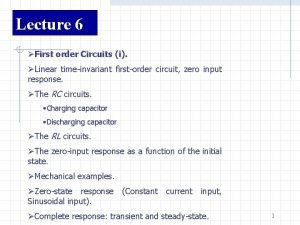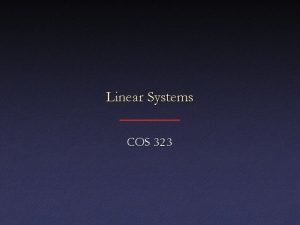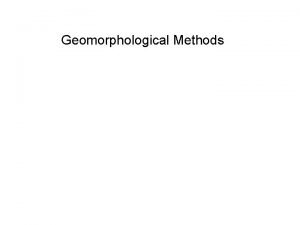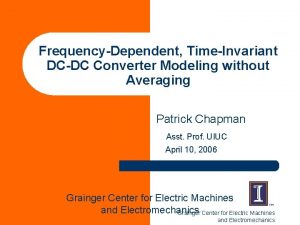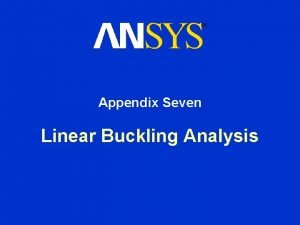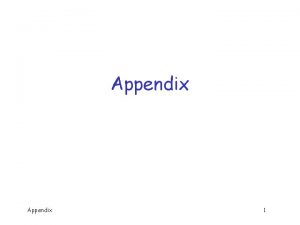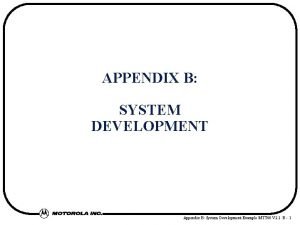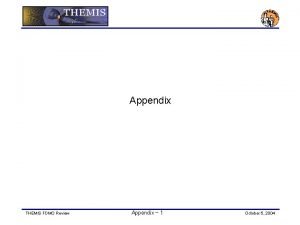Appendix 02 Linear Systems Timeinvariant systems ft Linear







![Impulse Response [1/4] 8 Impulse Response [1/4] 8](https://slidetodoc.com/presentation_image_h2/f1f8cca73b1fcea6f3afc6a6896a8d7c/image-8.jpg)
![Impulse Response [2/4] f(t) h(t) g(t) F( ) H( ) G( ) 9 Impulse Response [2/4] f(t) h(t) g(t) F( ) H( ) G( ) 9](https://slidetodoc.com/presentation_image_h2/f1f8cca73b1fcea6f3afc6a6896a8d7c/image-9.jpg)
![Impulse Response [3/4] Convolution g(t) t 10 Impulse Response [3/4] Convolution g(t) t 10](https://slidetodoc.com/presentation_image_h2/f1f8cca73b1fcea6f3afc6a6896a8d7c/image-10.jpg)
![Impulse Response [4/4] Convolution = * 11 Impulse Response [4/4] Convolution = * 11](https://slidetodoc.com/presentation_image_h2/f1f8cca73b1fcea6f3afc6a6896a8d7c/image-11.jpg)


![The Impulse Function [1/2] The impulse is the identity function under convolution 14 The Impulse Function [1/2] The impulse is the identity function under convolution 14](https://slidetodoc.com/presentation_image_h2/f1f8cca73b1fcea6f3afc6a6896a8d7c/image-14.jpg)
![The Impulse Function [2/2] 15 The Impulse Function [2/2] 15](https://slidetodoc.com/presentation_image_h2/f1f8cca73b1fcea6f3afc6a6896a8d7c/image-15.jpg)
![Step Function [1/3] b b 16 Step Function [1/3] b b 16](https://slidetodoc.com/presentation_image_h2/f1f8cca73b1fcea6f3afc6a6896a8d7c/image-16.jpg)
![Step Function [2/3] b b 17 Step Function [2/3] b b 17](https://slidetodoc.com/presentation_image_h2/f1f8cca73b1fcea6f3afc6a6896a8d7c/image-17.jpg)
![Step Function [3/3] b 18 Step Function [3/3] b 18](https://slidetodoc.com/presentation_image_h2/f1f8cca73b1fcea6f3afc6a6896a8d7c/image-18.jpg)


![Discrete 1 -Dim Convolution [1/5] Matrix 21 Discrete 1 -Dim Convolution [1/5] Matrix 21](https://slidetodoc.com/presentation_image_h2/f1f8cca73b1fcea6f3afc6a6896a8d7c/image-21.jpg)
![Discrete 1 -Dim Convolution [2/5] Example 22 Discrete 1 -Dim Convolution [2/5] Example 22](https://slidetodoc.com/presentation_image_h2/f1f8cca73b1fcea6f3afc6a6896a8d7c/image-22.jpg)
![Discrete 1 -Dim Convolution [3/5] Discrete operation 23 Discrete 1 -Dim Convolution [3/5] Discrete operation 23](https://slidetodoc.com/presentation_image_h2/f1f8cca73b1fcea6f3afc6a6896a8d7c/image-23.jpg)
![Discrete 1 -Dim Convolution [4/5] Graph - Continuous / Discrete 24 Discrete 1 -Dim Convolution [4/5] Graph - Continuous / Discrete 24](https://slidetodoc.com/presentation_image_h2/f1f8cca73b1fcea6f3afc6a6896a8d7c/image-24.jpg)
![Discrete 1 -Dim Convolution [5/5] Wrapping h index array 25 Discrete 1 -Dim Convolution [5/5] Wrapping h index array 25](https://slidetodoc.com/presentation_image_h2/f1f8cca73b1fcea6f3afc6a6896a8d7c/image-25.jpg)

![Discrete Two-Dimensional Convolution [1/3] 27 Discrete Two-Dimensional Convolution [1/3] 27](https://slidetodoc.com/presentation_image_h2/f1f8cca73b1fcea6f3afc6a6896a8d7c/image-27.jpg)
![Discrete Two-Dimensional Convolution [2/3] 28 Discrete Two-Dimensional Convolution [2/3] 28](https://slidetodoc.com/presentation_image_h2/f1f8cca73b1fcea6f3afc6a6896a8d7c/image-28.jpg)
![Discrete Two-Dimensional Convolution [3/3] Kernel matrix Input image Array of products Output image Summer Discrete Two-Dimensional Convolution [3/3] Kernel matrix Input image Array of products Output image Summer](https://slidetodoc.com/presentation_image_h2/f1f8cca73b1fcea6f3afc6a6896a8d7c/image-29.jpg)


- Slides: 31

Appendix 02 Linear Systems - Time-invariant systems f(t) Linear System g(t) 1

Linear System A linear system is a system that has the following two properties: Homogeneity: Scaling: The two properties together are referred to as superposition. 2

Time-invariant System A time-invariant system is a system that has the property that the shape of the response (output) of this system does not depend on the time at which the input was applied. If the input f is delayed by some interval T, the output g will be delayed by the same amount. 3

Harmonic Input Function Linear time-invariant systems have a very interesting (and useful) response when the input is a harmonic. If the input to a linear time-invariant system is a harmonic of a certain frequency , then the output is also a harmonic of the same frequency that has been scaled and delayed: 4

Transfer Function H( ) The response of a shift-invariant linear system to a harmonic input is simply that input multiplied by a frequency-dependent complex number (the transferfunction H( )). A harmonic input always produces a harmonic output 5 at the same frequency in a shift-invariant linear system.

Transfer Function Convolution F( ) H( ) G( ) f(t) h(t) g(t) 6

Convolution f(t) h(t) g(t) 7
![Impulse Response 14 8 Impulse Response [1/4] 8](https://slidetodoc.com/presentation_image_h2/f1f8cca73b1fcea6f3afc6a6896a8d7c/image-8.jpg)
Impulse Response [1/4] 8
![Impulse Response 24 ft ht gt F H G 9 Impulse Response [2/4] f(t) h(t) g(t) F( ) H( ) G( ) 9](https://slidetodoc.com/presentation_image_h2/f1f8cca73b1fcea6f3afc6a6896a8d7c/image-9.jpg)
Impulse Response [2/4] f(t) h(t) g(t) F( ) H( ) G( ) 9
![Impulse Response 34 Convolution gt t 10 Impulse Response [3/4] Convolution g(t) t 10](https://slidetodoc.com/presentation_image_h2/f1f8cca73b1fcea6f3afc6a6896a8d7c/image-10.jpg)
Impulse Response [3/4] Convolution g(t) t 10
![Impulse Response 44 Convolution 11 Impulse Response [4/4] Convolution = * 11](https://slidetodoc.com/presentation_image_h2/f1f8cca73b1fcea6f3afc6a6896a8d7c/image-11.jpg)
Impulse Response [4/4] Convolution = * 11

Convolution Rules 12

Some Useful Functions A B a/2 b 13
![The Impulse Function 12 The impulse is the identity function under convolution 14 The Impulse Function [1/2] The impulse is the identity function under convolution 14](https://slidetodoc.com/presentation_image_h2/f1f8cca73b1fcea6f3afc6a6896a8d7c/image-14.jpg)
The Impulse Function [1/2] The impulse is the identity function under convolution 14
![The Impulse Function 22 15 The Impulse Function [2/2] 15](https://slidetodoc.com/presentation_image_h2/f1f8cca73b1fcea6f3afc6a6896a8d7c/image-15.jpg)
The Impulse Function [2/2] 15
![Step Function 13 b b 16 Step Function [1/3] b b 16](https://slidetodoc.com/presentation_image_h2/f1f8cca73b1fcea6f3afc6a6896a8d7c/image-16.jpg)
Step Function [1/3] b b 16
![Step Function 23 b b 17 Step Function [2/3] b b 17](https://slidetodoc.com/presentation_image_h2/f1f8cca73b1fcea6f3afc6a6896a8d7c/image-17.jpg)
Step Function [2/3] b b 17
![Step Function 33 b 18 Step Function [3/3] b 18](https://slidetodoc.com/presentation_image_h2/f1f8cca73b1fcea6f3afc6a6896a8d7c/image-18.jpg)
Step Function [3/3] b 18

Smoothing a function by convolution b 19

Edge enhancement by convolution b 20
![Discrete 1 Dim Convolution 15 Matrix 21 Discrete 1 -Dim Convolution [1/5] Matrix 21](https://slidetodoc.com/presentation_image_h2/f1f8cca73b1fcea6f3afc6a6896a8d7c/image-21.jpg)
Discrete 1 -Dim Convolution [1/5] Matrix 21
![Discrete 1 Dim Convolution 25 Example 22 Discrete 1 -Dim Convolution [2/5] Example 22](https://slidetodoc.com/presentation_image_h2/f1f8cca73b1fcea6f3afc6a6896a8d7c/image-22.jpg)
Discrete 1 -Dim Convolution [2/5] Example 22
![Discrete 1 Dim Convolution 35 Discrete operation 23 Discrete 1 -Dim Convolution [3/5] Discrete operation 23](https://slidetodoc.com/presentation_image_h2/f1f8cca73b1fcea6f3afc6a6896a8d7c/image-23.jpg)
Discrete 1 -Dim Convolution [3/5] Discrete operation 23
![Discrete 1 Dim Convolution 45 Graph Continuous Discrete 24 Discrete 1 -Dim Convolution [4/5] Graph - Continuous / Discrete 24](https://slidetodoc.com/presentation_image_h2/f1f8cca73b1fcea6f3afc6a6896a8d7c/image-24.jpg)
Discrete 1 -Dim Convolution [4/5] Graph - Continuous / Discrete 24
![Discrete 1 Dim Convolution 55 Wrapping h index array 25 Discrete 1 -Dim Convolution [5/5] Wrapping h index array 25](https://slidetodoc.com/presentation_image_h2/f1f8cca73b1fcea6f3afc6a6896a8d7c/image-25.jpg)
Discrete 1 -Dim Convolution [5/5] Wrapping h index array 25

Two-Dimensional Convolution 26
![Discrete TwoDimensional Convolution 13 27 Discrete Two-Dimensional Convolution [1/3] 27](https://slidetodoc.com/presentation_image_h2/f1f8cca73b1fcea6f3afc6a6896a8d7c/image-27.jpg)
Discrete Two-Dimensional Convolution [1/3] 27
![Discrete TwoDimensional Convolution 23 28 Discrete Two-Dimensional Convolution [2/3] 28](https://slidetodoc.com/presentation_image_h2/f1f8cca73b1fcea6f3afc6a6896a8d7c/image-28.jpg)
Discrete Two-Dimensional Convolution [2/3] 28
![Discrete TwoDimensional Convolution 33 Kernel matrix Input image Array of products Output image Summer Discrete Two-Dimensional Convolution [3/3] Kernel matrix Input image Array of products Output image Summer](https://slidetodoc.com/presentation_image_h2/f1f8cca73b1fcea6f3afc6a6896a8d7c/image-29.jpg)
Discrete Two-Dimensional Convolution [3/3] Kernel matrix Input image Array of products Output image Summer x. C Scaling factor Output pixel 29

Linear System - Fourier Transform Impulse respons Input function f(t) Spectrum of input function F( ) h(t) H( ) g(t) Output function G( ) Spectrum of output function Transfer function 30

End 31
 Qualitative proposal example
Qualitative proposal example How to write a report example
How to write a report example How to put an appendix in a paper mla
How to put an appendix in a paper mla Marvel appendix
Marvel appendix Blood supply of colon
Blood supply of colon Appendix powerpoint template
Appendix powerpoint template Hiatus muscularis appendix
Hiatus muscularis appendix Foramen epiploicum
Foramen epiploicum Marketing plan appendix
Marketing plan appendix Dss risk management framework
Dss risk management framework Rmf continuous monitoring
Rmf continuous monitoring Lc-3 instruction set
Lc-3 instruction set Lc3 br instruction
Lc3 br instruction Fatigue tool ansys
Fatigue tool ansys Appendix section
Appendix section What is an appendix writing
What is an appendix writing Appendix
Appendix Nanda nsg lmplemntation of appndectomy
Nanda nsg lmplemntation of appndectomy Appendicitis anatomy and physiology
Appendicitis anatomy and physiology Appendices or appendix
Appendices or appendix Appendix 1 spelling
Appendix 1 spelling Rat dissection
Rat dissection Appendix c machine language
Appendix c machine language Appendix - 1 (pr-pts)
Appendix - 1 (pr-pts) Etiology of appendectomy
Etiology of appendectomy Rockey davis incision
Rockey davis incision Shrek satire worksheet
Shrek satire worksheet Lingul tonsil
Lingul tonsil Appendix graph
Appendix graph Appendix slides
Appendix slides Hedge statement
Hedge statement Appendix company profile
Appendix company profile


